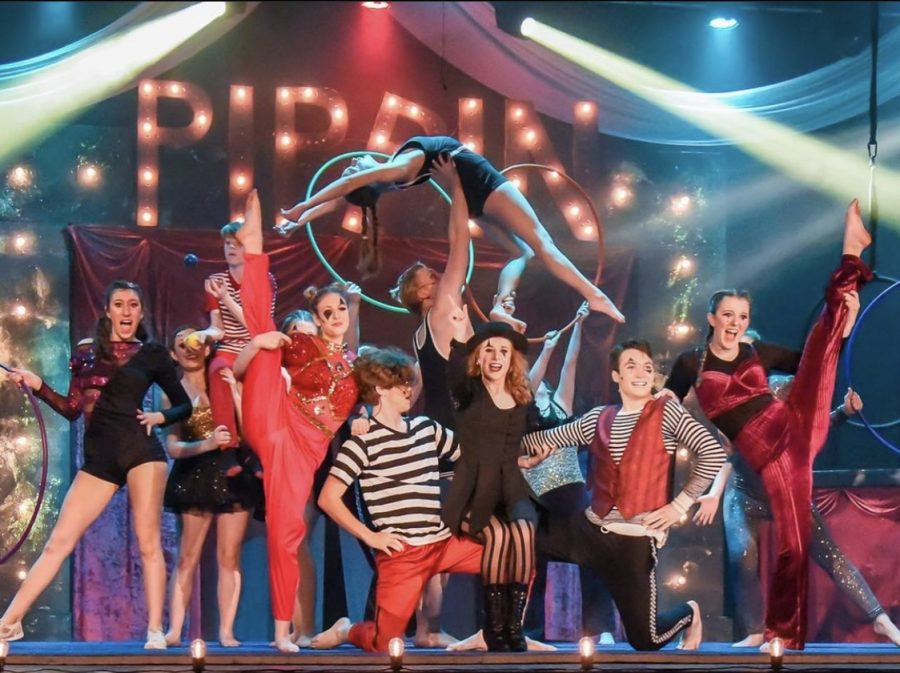A night of exhibition and excitement
Starr’s Mill drama department presents “Pippin” as their yearly musical
Photo via Instagram (@smhsthespians)
The cast of “Pippin” pose onstage. For their annual musical, the Starr’s Mill drama department chose “Pippin,” a performance that showcases musical talent as well as circus and silk aerobic acts and includes the audience at every possible moment.
For the annual musical, the Starr’s Mill drama department presented “Pippin” and introduced never-before-seen acts.
“On the surface, we try to do a show that’s going to encourage them to learn a new set of skills,” Starr’s Mill drama teacher Lauren Kuykendall said. “This one required cirque training and we decided to do [it] to incorporate some cirque elements into our program.”
The cirque acts included throughout the musical showcased a level of talent that takes time to perfect. As their first time doing a musical with circus acts and even aerial silk aerobics, I was thoroughly impressed. Everyone on stage knew what they were doing and it worked amazingly well with the feel of the play as well as adding to the circus setting.
“When you first start it’s difficult because you can’t really remember anything, but once you get it in your body, you start remembering where to go… [and] things fall into place,” junior Hayden Andrews, who starred as Pippin, said.
The premise of “Pippin” is slightly complicated. At its core, it is a frame story told from the point-of-view of players in a circus. They are well aware of the audience sitting before them and even interact with them multiple times.
As the circus players act out the story of “Pippin,” the actors playing Pippin and Catherine fall in love and stray away from the plot. As they act out of turn, the leading player begins to get frustrated and plans Pippin’s murder. In the end, Pippin finds his true purpose in life, living happily ever after with his co-star who plays Catherine.
“Those big numbers where there’s the potential for people to run into one another or for things to go awry,” junior Matthew Little, playing King Charlemagne, said, “we’ve just drilled them to the point where it’s in our muscle memory and it would be difficult to move to the wrong spot.”
The whole cast of “Pippin” brought tons of magic to the show. The audience interactions, both during the play and even during intermission and before the show started, made the entire play feel inclusive. Many characters would walk into the crowd during some musical numbers and one even required the audience to sing along. The entire show had the audience clapping, cheering, and even laughing.
“It’s physically difficult for the actors on stage but it also changes how we do microphones, how we do costumes, so really how we do everything,” Kuykendall said.
Toward the end of the plot, the crowd slowly begins to notice that some actors, like Catherine, are acting out of turn, hinting that something bigger is going on behind the scenes. The cast was skillful in the way that they created suspense on stage.
As Catherine sings a song that she was not supposed to and the leading player gets angry, viewers notice that the leading player is actually planning Pippin’s death. Once the finale takes place, it ends up derailing from the original plot. Pippin does not fall for the leading player’s trick and the entire audience can feel the heavy tension between Pippin and the leading player.
“Obviously, it says I’m the head director, which is true, I delegate all the stuff, but we had a really stout creative team,” Kuykendall said. “Having four people on [the show], being able to kind of put our heads together, made it less [challenging].”
As a performance that exhibited many incredible talents and included the crowd in many ways, “Pippin” left audiences in wonder and amazement.



Henry Ravita • Mar 1, 2022 at 8:41 pm
I wouldn’t say that leading player wants to murder Pippin, but rather tell him that to be truly extraordinary he must meet an extraordinary end. Pippin accepts that life isn’t always exciting and glorious, and decides to abandon the players to pursue something truly fulfilling, love.